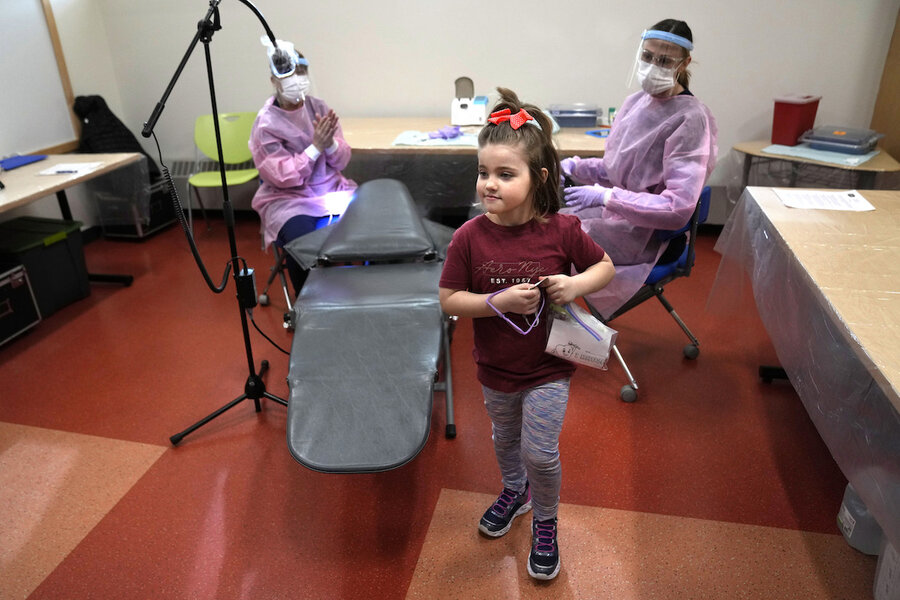Math, English, and bright smiles. Traveling dental care in schools fills a gap.
Loading...
| Concord, N.H.
Tucked away inside the teachers lounge at a New Hampshire elementary school, Amber Warner was having her teeth checked out for the first time.
The 5-year-old sat back on what looked like a beach chair and wore a pair of dark sunglasses as certified public health dental hygienist Mary Davis surveyed Amber’s teeth, administered a dental sealant, and flossed Amber’s teeth. The whole visit took 15 minutes.
“Look at you. You are a pro on your first dental visit. I am so proud of you,” Ms. Davis said to the kindergartener, who got up from the chair and was hugged by a teacher’s assistant.
The portable clinic is part of a cavity prevention program developed by NYU College of Dentistry and is being rolled out in Concord and two other New Hampshire districts. CariedAway New Hampshire hopes to expand to Maine and Vermont – and eventually nationwide – as part of a growing effort to improve pediatric oral health, especially in children from lower-income families.
There isn’t a good national estimate of dental programs in schools but many larger school districts have them. Boston University’s program operates in 20 schools and 30 preschools in Boston and eight other cities in Massachusetts and covers 3,000 children from six months to 21 years. In New York City, 81,000 students across 820 schools – a little over half of all public schools – were treated last school year.
Nationwide Children’s Hospital has seen 1,700 children in central Ohio since 2021 with its roving school-based dental clinics, while Minnesota nonprofit Ready, Set, Smile is in 44 schools in the Twin Cities, serving 2,225 children.
“Dental care typically is looked at as an extra or an add-on,” said Terri Chandler, who is the founder and executive director of Future Smiles in Clark County, Nevada, which includes Las Vegas and serves 7,500 kids in 75 schools. “It is not part of medical care.”
Nearly half of all U.S. children don’t receive regular dental care, according to a 2022 report from the National Institute of Dental and Craniofacial Research, which is a federal agency.
Too many children fail to see a dentist before they enter school – forcing them to go to the hospital to get treatment for a mouthful of cavities, Harvard School of Dental Medicine’s Catherine Hayes said. She added: “... It’s completely preventable. We know how to prevent it.”
At Boston Children’s Hospital, there’s a waiting list of eight to nine months for the dental clinic, said Man Wai Ng, the dentist-in-chief. Ms. Ng points in part to worsening dental care during the pandemic.
“I have patients who were going to bed without brushing their teeth. They ate and drank at all hours of the day because those normal daily routines weren’t there,” Ms. Ng said. “They weren’t able to get in for ... preventive dental care.”
Ruth Langwell struggled to find a dentist for her granddaughter Lola, a 10-year-old who has autism. She recently was able to get the girl into the clinic.
“She needs somebody who is very patient, obviously ... We’ve tried two other dentist and they have been reluctant because of Lola’s challenges,” said Ms. Langwell, who added she wanted Lola to see a dentist at age 2, but didn’t until she was 5.
Funding programs to build habits
The challenge for many programs, especially mobile and school-based clinics, is sustainability, said Richard Niederman, a professor of epidemiology and health promotion at NYU Dentistry and founder of CariedAway. That’s because school-based programs like Mr. Neiderman’s lean heavily on donations because they often serve low-income populations who are either uninsured or on Medicaid.
Mr. Niederman has spent two decades developing his program. Other ones he tried in the Bronx and Boston ended due to a lack of funding, but this time, Mr. Niederman has $1 million from Northeast Delta Dental, which ensures his New Hampshire program will remain in place for at least three years.
“It breaks my heart that kids don’t get effective care that they could get ... and the system doesn’t support it,” he said.
But the picture for pediatric oral health is improving – even outside of school programs.
Jane Grover, the senior director of the American Dental Association’s Council on Advocacy for Access and Prevention, said there has been “tremendous growth” of dental programs in community health centers, as well as efforts to deploy dental hygienists in pediatric offices.
Some states are also better at coordinating pediatric and dental care. MassHealth, the Medicaid program in Massachusetts, started requiring physicians last year to ensure a child has two fluoride varnish applications and refer them to a dentist, Ms. Hayes said.
Mr. Neiderman’s team treated more than 60 students over a week at the Concord school. Among them was softspoken 10-year-old Evette Sesay, who dutifully detailed how she brushes twice a day and flosses.
She said it felt like a typical exam at her dentist’s office: “They cleaned my teeth very well. The bubble gum flavor was good, too.”
This story was reported by The Associated Press.







